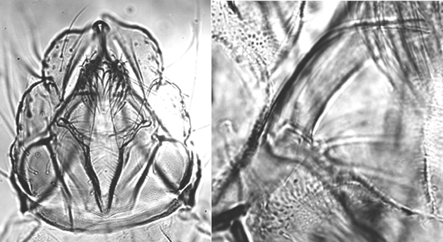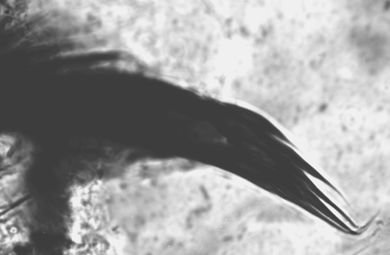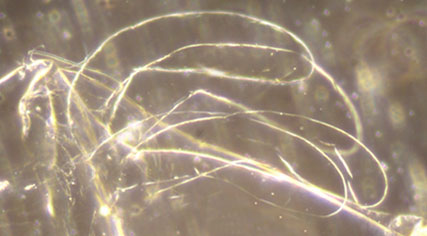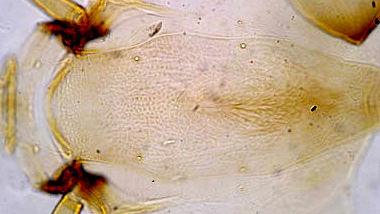Species b. C. decorus group
'C. parablaylocki'This species is cytologically closely related to C. blaylocki, with which it shares banding sequences. It is suggested that this species be named 'C. parablaylocki'.The suggested holotype would be the slide of larval body and polytene chromosomes from Copanspin Farm, Dunrobin, Onario, Canada CO.23.15 81M. A photograph of the polytene chromosome complement of this larva was published in Wülker et al. (2009).
The male below would be a paratype male. Adult:
Male: The adult male is a typical member of the C. decorus-group. Setae on TIX in single spots. The gonostylus is relatively short and stout compared to those of C. bifurcatus or C. blaylocki, narrowing sharply over distal quarter. The superior volsella shows similarities to that of C. blaylockii.e. S-type, closest to Strenzke"s figure c. Inferior volsella with simple setae, reaching to about middle of the gonostylus.
Male terminalia of C. species b.
Note relatively short gonostylus, and the superior volsella similar to that of C. blaylocki.Female: No information available. Pupa: Caudolateral spur of segment VIII (below) with about 5 spines along the outer margin.
 Fourth instar larva a moderate sized (female 15.9 (14.4-17.2) mm; male 13.9 (12.0-15.3) mm.) plumosus-type with long ventral tubules, posterior pair normally longer (anterior 1.97 (1.6-2.3 mm); posterior 2.29 (1.6-2.3) mm). Length, female 14.4-17.2 mm; male 12.0-15.3 mm. Lateral projections about 256.9 (170-360) µm. Anal tubules (below) relatively long, about 4.0-4.4 times longer than wide; with a median constriction, length about 559 (557-700) micron, ventral pair may be narrower.  Gular region darkened, frontoclypeus (below) normally darkened, occasionally pale. Gular region darkened, frontoclypeus (below) normally darkened, occasionally pale.
 Salivary reservoir about 67 (55.5-86) µm long and 1.2-4.3 time longer than deep (lower values possibly due to flattening during slide mounting).
Mentum (Fig. c) width about half the ventral head length; with slightly rounded teeth, c2 teeth of centre trifid tooth well seperated (type III or IB if worn); fourth laterals not reduced (type I).
Ventromental plates (Fig. d) about 221 (210-233) µm wide and 3.73 (3.54-4.09) µm wider than deep; about 1.22 (1.17-1.29) times the mentum width; separated by about one third of the mentum width, with about 44-47 striae; VMR about 3.2, increasing towards midline.
Pecten epipharyngis (Fig. a) with about 14 (12-16) relatively broad teeth (type B).
Premandible (Fig. b) with broad teeth, often broken or worn, inner tooth about 4.3 (3-6) times the width of the outer which comes to a fine point (Type B2).
Antenna (Fig. f) with basal segment 0.36-0.41 of VHL and about 3.6 times as long as wide; Ring organ just less than halfway up A1; A3 just shorter than A4, and just longer than A5; proportions (µm): 128 : 33.5 : 10 : 11.5 : 8. AR about 2.03 (1.87-2.12.
Distance between the antennal bases (154.2 (134-170) µm) slightly less than the width between S4 setae (160.3 (135-182) &181;m) which is 0.8-0.85 of the FC width at that point; S5 setae about level with nearby RO (see figure above).
Mandible (Fig. e) about 240-250 µm long, with 3rd inner tooth partly darkened, but not well separated (type IIA-B), with about 15.3 (14-20) furrows on the outer surface at the base; about 13 (11-14) taeniae in the Pecten mandibularis; Mdt-Mat about 21(20-22.5) µm.; MTR about 0.3 (0.25-0.36). Cytology: 4 polytene chromosomes with thummi arm combination AB, CD, EF, G.
Arm G normally paired with subterminal nucleolus, a Balbiani ring about one third and a further small one about 2/3 of distance to other end. No other nucleoli.
Polymorphic in arms A, B, D, E & F. pbl A1: 1a-e, 4d-a, 13-15, 3e-2d, 9-8, 5-7, 16d-a, 1f-2c, 10-12, 3i-f, 17-19 (Wülker)
pbl A2: approx. 1a-e, 4d, 10a-e, 2c-1f, 16d-a, 7-5, 8-9, 2d-3a, 15-13, 4a-c, 11-12, 3i-f, 17-19
pbl B1: Puff with proximal dark bands (groups 7 and 8) near distal end of arm.
pbl B2: Puff with distal dark bands (groups 8 and 7) about 1/3 from end of arm, possibly as blaylocki B1
pbl C1: possibly as C2 of blaylocki
pbl D1:
pbl D2: Simple inversion of proximal half of arm.
pbl E1: 1 - 3e, 5 - 10b, 4 - 3f, 10c - 13 i.e. as maturus, stigmaterus, blaylocki
pbl E2: approx. 1 - 3e, 6 - 8, 5, 9 - 10b, 4 - 3f, 10c - 13
pbl F1: 1, 9 - 2, 10 - 23 i.e. as blaylocki F1
pbl F2: 1, 9 - 2, 10a-d, 17 - 11, 18 - 23 (Wülker)
pbl G1: Nucleolus subterminal as in C. blaylocki, but with the largest BR much further away and closer to a smaller distal BR.Found: New Bruswick - Kouchibouguac River, Kouchibouguac National Park (abt 46.50°N, 65.33°W)
OntarioCopanspin Farm, Dunrobin, Carleton Co. (45.42°N, 75.87°W)(Intended type locality); Bear Creek, Carlsbad Springs, Russel Co. (45.37°N, 75.47°W).
Wisconsin - Arboretum, Madison, Dane Co. (43.08°N, 89.42°W). Shallow pools, including in creeks. This species is very close to C. blaylocki. Wolfgang Wülker suggested it was a subspecies, but the larval antennal proportions at least are different (largely a longer A1 in that species).
Some information on larval morphology and a photograph of the chromosome complement is given in Wülker et al. (2009) See also C. blaylocki, C. harpi, C. bifurcatus, C. sp. c, C. sp. j, C. sp. 2a, C. sp. 2b, C. decorus gp. sp. 2, C. decorus Joh., C. sp. 3h, C. sp. 3i, C. sp. 3j, C. sp. 3r, C. mozleyi, C. winnelli.[ Return to Index ] |